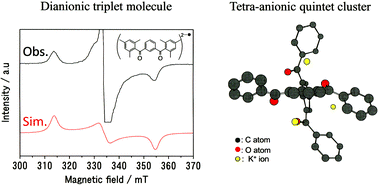Organic polyanionic high-spin molecular clusters: topological-symmetry controlled models for organic ferromagnetic metals†
Abstract
Trianionic spin-quartet and tetraanionic spin-quintet molecular clusters derived from

* Corresponding authors
a
Departments of Chemistry and Materials Science, Graduate School of Science, Osaka City University, 3-3-138, Sugimoto, Sumiyoshi-ku, Osaka 558-8585, Japan
E-mail:
s-nakaza@sci.osaka-cu.ac.jp, sato@sci.osaka-cu.ac.jp, takui@sci.osaka-cu.ac.jp
b CREST-JST, Chiyoda-ku, Tokyo 102-0075, Japan
c Department of Chemistry, Instituto Superior Técnico, Universidade Técnica de Lisboa, Avenida Rovisco Pais, 1049-001 Lisboa, Portugal
Trianionic spin-quartet and tetraanionic spin-quintet molecular clusters derived from

 Please wait while we load your content...
Something went wrong. Try again?
Please wait while we load your content...
Something went wrong. Try again?
S. Nakazawa, K. Sato, D. Shiomi, M. Yano, T. Kinoshita, M. L. T. M. B. Franco, M. C. R. L. R. Lazana, M. C. B. L. Shohoji, T. L. K. Itoh and T. Takui, Phys. Chem. Chem. Phys., 2011, 13, 1424 DOI: 10.1039/C0CP00730G
To request permission to reproduce material from this article, please go to the Copyright Clearance Center request page.
If you are an author contributing to an RSC publication, you do not need to request permission provided correct acknowledgement is given.
If you are the author of this article, you do not need to request permission to reproduce figures and diagrams provided correct acknowledgement is given. If you want to reproduce the whole article in a third-party publication (excluding your thesis/dissertation for which permission is not required) please go to the Copyright Clearance Center request page.
Read more about how to correctly acknowledge RSC content.
 Fetching data from CrossRef.
Fetching data from CrossRef.
This may take some time to load.
Loading related content
